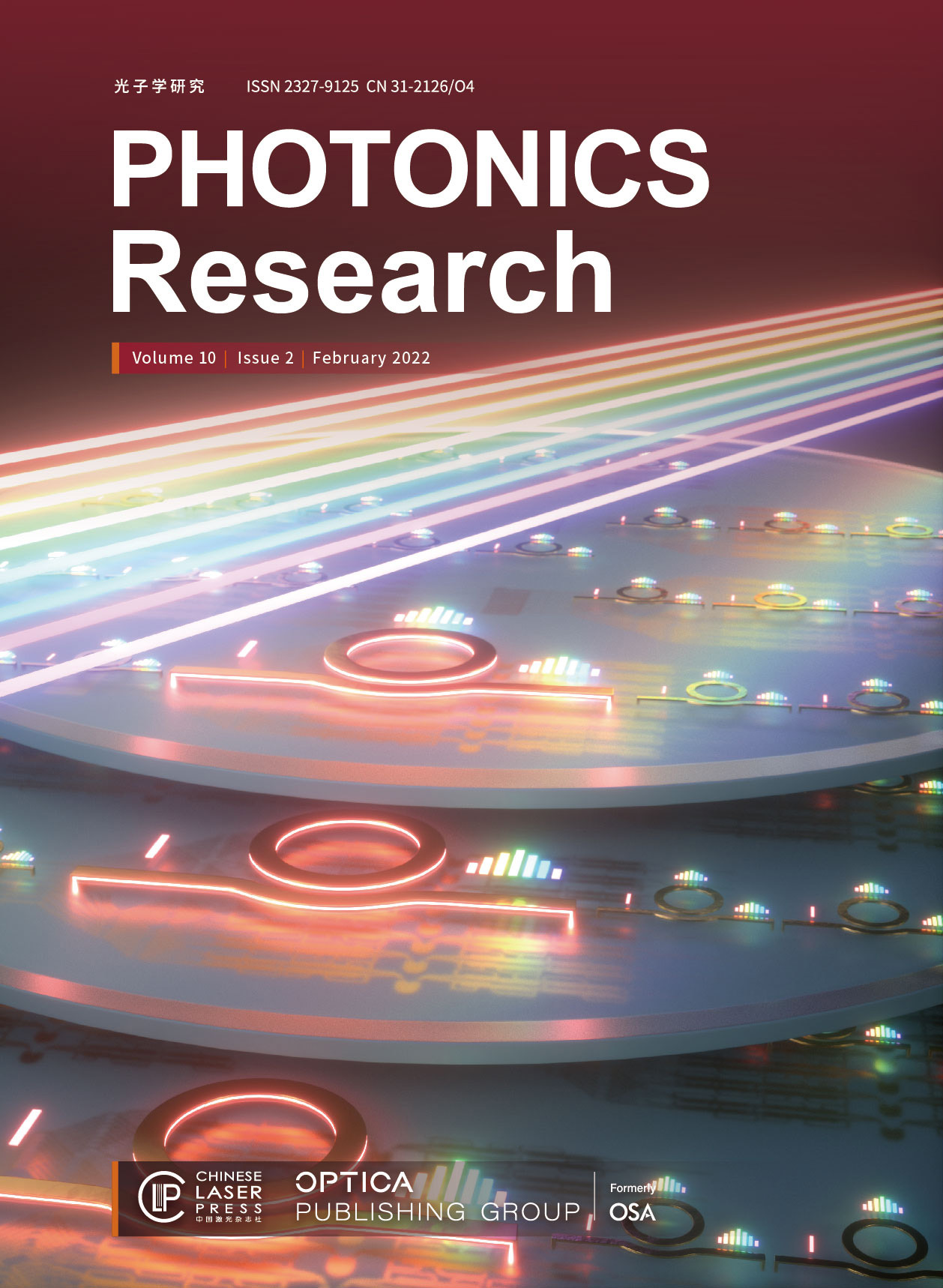The emerging fields of silicon (Si) photonic micro–electromechanical systems (MEMS) and optomechanics enable a wide range of novel high-performance photonic devices with ultra-low power consumption, such as integrated optical MEMS phase shifters, tunable couplers, switches, and optomechanical resonators. In contrast to conventional
- Publication Date: Jan. 14, 2022
- Vol. 10, Issue 2, A14 (2022)
We discuss the design and demonstration of various III–V/Si asymmetric Mach–Zehnder interferometer (AMZI) and ring-assisted AMZI (de-)interleavers operating at O-band wavelengths with 65 GHz channel spacing. The wafer-bonded III–V/Si metal-oxide-semiconductor capacitor (MOSCAP) structure facilitates ultra-low-power phase tuning on a heterogeneous platform that allows for complete monolithic transceiver photonic integration. The second- and third-order MOSCAP AMZI (de-)interleavers exhibit cross-talk (XT) levels down to
- Publication Date: Jan. 24, 2022
- Vol. 10, Issue 2, A22 (2022)
- Publication Date: Jan. 14, 2022
- Vol. 10, Issue 2, 357 (2022)
- Publication Date: Jan. 07, 2022
- Vol. 10, Issue 2, 289 (2022)
- Publication Date: Jan. 11, 2022
- Vol. 10, Issue 2, 323 (2022)
- Publication Date: Jan. 07, 2022
- Vol. 10, Issue 2, 303 (2022)
- Publication Date: Jan. 24, 2022
- Vol. 10, Issue 2, 433 (2022)
- Publication Date: Feb. 01, 2022
- Vol. 10, Issue 2, 491 (2022)
- Publication Date: Feb. 01, 2022
- Vol. 10, Issue 2, 542 (2022)
- Publication Date: Feb. 01, 2022
- Vol. 10, Issue 2, 550 (2022)
- Publication Date: Feb. 01, 2022
- Vol. 10, Issue 2, 535 (2022)
- Publication Date: Feb. 01, 2022
- Vol. 10, Issue 2, 564 (2022)
- Publication Date: Jan. 11, 2022
- Vol. 10, Issue 2, 340 (2022)
- Publication Date: Jan. 24, 2022
- Vol. 10, Issue 2, 444 (2022)
- Publication Date: Jan. 24, 2022
- Vol. 10, Issue 2, 465 (2022)
- Publication Date: Feb. 01, 2022
- Vol. 10, Issue 2, 483 (2022)
- Publication Date: Feb. 01, 2022
- Vol. 10, Issue 2, 524 (2022)
- Publication Date: Jan. 07, 2022
- Vol. 10, Issue 2, 297 (2022)
- Publication Date: Jan. 14, 2022
- Vol. 10, Issue 2, 373 (2022)
- Publication Date: Feb. 01, 2022
- Vol. 10, Issue 2, 503 (2022)
- Publication Date: Feb. 01, 2022
- Vol. 10, Issue 2, 509 (2022)
- Publication Date: Feb. 01, 2022
- Vol. 10, Issue 2, 601 (2022)
- Publication Date: Jan. 14, 2022
- Vol. 10, Issue 2, 381 (2022)
- Publication Date: Feb. 01, 2022
- Vol. 10, Issue 2, 594 (2022)
- Publication Date: Sep. 29, 2021
- Vol. 10, Issue 2, 269 (2022)
- Publication Date: Jan. 14, 2022
- Vol. 10, Issue 2, 401 (2022)
- Publication Date: Jan. 24, 2022
- Vol. 10, Issue 2, 407 (2022)
- Publication Date: Jan. 24, 2022
- Vol. 10, Issue 2, 426 (2022)
- Publication Date: Feb. 01, 2022
- Vol. 10, Issue 2, 516 (2022)
- Publication Date: Feb. 01, 2022
- Vol. 10, Issue 2, 587 (2022)
- Publication Date: Feb. 01, 2022
- Vol. 10, Issue 2, 557 (2022)
- Publication Date: Feb. 01, 2022
- Vol. 10, Issue 2, 574 (2022)
- Publication Date: Jan. 14, 2022
- Vol. 10, Issue 2, 389 (2022)
- Publication Date: Jan. 24, 2022
- Vol. 10, Issue 2, 456 (2022)
- Publication Date: Jan. 28, 2022
- Vol. 10, Issue 2, 475 (2022)
- Publication Date: Jan. 11, 2022
- Vol. 10, Issue 2, 347 (2022)
- Publication Date: Jan. 11, 2022
- Vol. 10, Issue 2, 332 (2022)
- Publication Date: Jan. 07, 2022
- Vol. 10, Issue 2, 280 (2022)
- Publication Date: Jan. 11, 2022
- Vol. 10, Issue 2, 316 (2022)
- Publication Date: Jan. 24, 2022
- Vol. 10, Issue 2, 416 (2022)
- Publication Date: Feb. 01, 2022
- Vol. 10, Issue 2, 610 (2022)
- Publication Date: Jan. 14, 2022
- Vol. 10, Issue 2, 365 (2022)
This publisher’s note reports corrections to the text in
- Publication Date: Jan. 14, 2022
- Vol. 10, Issue 2, 364 (2022)
This erratum corrects a clerical error in the original manuscript [
- Publication Date: Jan. 24, 2022
- Vol. 10, Issue 2, 415 (2022)
About the Cover
Highly-nonlinear, high-Q III-microresonators, heterogeneously integrated with Si photonic integrated circuits, enable high-efficiency on-chip nonlinear processes. The demonstration lights up new opportunities for conventional Si photonics in implementing nonlinear light sources for innovative applications at system level on large scale.















